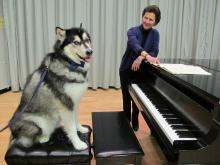Recent in-kind gifts and new purchases have allowed the School of Music to make needed upgrades to its aging piano fleet. Now the School has embarked on a renewed effort to raise funds for additional enhancements to this vital resource that benefits every area of the school and its degree programs.
Of all the musical instruments in play at the School of Music, the piano stands apart in its relevance to the study and performance of nearly every individual affiliated with the school, whether they be student, faculty, visiting scholar, or audience member. That truth extends beyond the school’s performance program to programs such as Composition, History, Theory, and Education. Most UW music majors must pass piano proficiency exams to receive a degree in music and complete ear training reliant on the piano in fulfillment of their degree requirements. Piano accompaniment is often an integral component of instrumental and vocal lessons, ensemble performances, and rehearsals, as well as the special performances by visiting concert artists who perform at Meany Hall or the School of Music’s Brechemin Auditorium.
The School’s 100-plus pianos see constant, heavy use. Doug Wood, one of the the School’s piano technicians, estimates the average School of Music practice piano receives 70 to 100 hours of use per week (compared to ten or less for the average home piano).
Most of the pianos in constant use at the school have been in service for many years. The average age of the school’s pianos is 53, which is downright elderly in piano terms. Unlike some instruments whose tone improves with age, pianos are not like fine wines.
As Wood’s colleague Susan Willanger-Cady frequently says, “Just because it’s old, doesn’t mean it’s better.” She and Wood together oversee maintenance and repair of the school’s pianos and are constantly tasked with breathing new life into old pianos, a job at which they both excel.
But even with their care and expertise and the decades of detailed care they have paid the School’s pianos, the rate of use and the passing of time have naturally diminished the quality of these workhorse instruments so important to the School’s educational missions.
New acquisitions spur grand shuffle
It was therefore a cause for celebration in early 2015 when the School of Music sent piano professors Robin McCabe and Craig Sheppard to the Steinway showroom in New York City to select new Steinway and Sons pianos for the School of Music: a nine-foot “D” concert grand for the main stage at Meany Hall and a 7-foot “B” grand for studio use. The School also added a slightly smaller “A” grand for classroom use as well as three 45-inch studio uprights.
The purchases, made possible with support from the College of Arts and Sciences, are intended to kick off a concentrated fundraising effort in support of additional piano acquisitions.
The new arrivals spurred a shuffle of pianos in the School’s practice studios and performance stages requiring a team of experienced piano movers to navigate some serious logistical challenges. An older, but still beloved Steinway “D,” earmarked for Room 214 of the Music Building, which has recently been renovated for chamber music rehearsal, was far too large to fit in the school’s elevators and had to be gingerly, carefully, painstakingly inched, on a skid, up several long flights of stairs by four brawny piano movers to reach its destination.
Considering this feat as well as the bottom line—the average cost of a Steinway grand ranges from around $75,000 to $125,000—one might conclude that the School faces a similarly arduous uphill climb to reach a complete refurbishment of its piano inventory. But School of Music director Richard Karpen says he is optimistic the school’s friends and alumni will step forward in support of this ongoing effort.
“The replacement of more than 100 pianos is a long-term process, and we cannot do it on our own,” he says. “We are enormously grateful for the new instruments we were able to purchase this year and for several high-quality instruments we have received in recent years from generous friends of the School of Music. But we have a substantial way to go to reach our goal of completely replenishing our piano inventory. You can’t have a great school of music without pianos,” he adds. “But I am confident that the school’s friends and supporters will understand the critical importance of this resource and support our efforts in this area of need.”
Together We Will:
Build a better piano fleet
The School of Music’s piano fleet is a critical resource used by nearly every faculty and student across the School’s degree programs. Our pianos receive heavy use throughout our performance venues, faculty studios, classrooms, and practice rooms. With your help, we can make needed upgrades and improvements to our piano fleet, ensuring that our students and faculty have access to the resources they need to achieve their educational and artistic aspirations.
To make a gift in support of the School of Music’s Piano Fund, visit www.music.washington.edu/support-us or contact Michael Toomey at toomeym@uw.edu.
By the Numbers:
Key facts about our piano inventory
109–Number of pianos in our fleet
53–Average age of our pianos
79–Percentage of our piano fleet acquired before 1980
29–Average age of practice pianos for piano majors
66–Number of pianos in our fleet manufactured by Steinway & Sons
70 to 100–Typical number of hours of use our practice pianos see each week
230–Number of strings on a piano
2,530–Number of strings on 109 pianos
1,400–Weight, in pounds, of a brand new, in-the-box Steinway D
